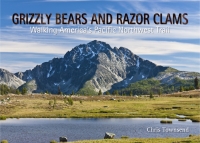Going through the many items I’ve tested for TGO magazine in
2011 I’ve come up with my favourites. They’re not necessarily the best in their
class – though several of them are – but they are ones that have impressed me most
this year.
I’ve only included gear that is generally available (though
with one item this does mean ordering from the USA and then waiting awhile) so
I’ve omitted Colin Ibbotson’s superb range of Tramplite Skins packs (see my post for April 21 and April 22) as Colin has decided that producing
these at present would interfere with his long distance walking plans. Much as
I’d like to see his packs on the market he definitely has his priorities right.
The items are in no particular order.
Rab Stretch Neo
Jacket in Polartec Neoshell
After a decade with no significant developments in
waterproof/breathable fabrics 2011 saw two new ones launched. The first of
these was Polartec Neoshell. I had the chance to test a Rab Stretch Neo jacket
in this fabric back in February on a two week trek on the Southern Upland Way
and was impressed with the performance. Neoshell is certainly as breathable as
eVent, the best fabric so far, and maybe more so. The Neo Stretch is a
well-designed jacket too, especially for mountain storms.
Gore-Tex Active Shell
Not to be outdone Gore-Tex came up with its own new fabric
called Active Shell. Only available in garments weighing 400 grams or less this
is more a fabric for summer use and lightweight backpacking. I tried two
garments, the Berghaus Velum and Haglofs Endo, and found the fabric as
breathable as Neoshell or eVent. Of the two designs I preferred the Velum,
mainly due to the big chest pockets.
At a mere 158 grams – lighter than many base layers – and compressible
into a tiny ball Patagonia ’s down shirt is
astonishing for the warmth provided. It’s also one of the most versatile down
garments as it can be layered with a synthetic fill or fleece top in cold
weather or used on its own as camp wear in summer. Indeed, the weight is such
there’s no reason to ever leave it behind.
PHD Hispar 500
I like to sleep comfortably and have never been one for
saving weight on a skimpy sleeping bag. At the same time I don’t want any more
weight than necessary. At 948 grams the Hispar 500 is much lighter than most other
bags with the same temperature rating. It’s currently my favourite winter bag.
Terra Nova Laser
Ultra 1
Despite the frightening expense and a somewhat fragile
groundsheet I just had to include the first cuben fibre two-skin tent from a mainstream
tent company due to the ridiculously low weight (anything from 580 to 800 grams
depending on pegs used – after ditching the toothpicks that came with the test
model I ended up with a weight of 788 grams including stuffsacks). I used the
Laser Ultra 1 on the Southern Upland Way and whilst a roomier shelter would
have been nice for the long winter nights it kept out the weather.
Boilerwerks
Backcountry Boiler
Innovative, ultralight and fun to use this modern take on
the venerable chimney kettle is an excellent meths/wood water boiler for
backpackers. The history of its design and development is fascinating too.
Jetboil Sol Ti
I liked the original Jetboil stove because it was innovative
and fuel efficient. However it was still quite heavy for backpacking compared
with alternative stove/pot combinations. The Sol Ti is much lighter at 248 grams (347
grams with all accessories) and a joy to carry and use.
Primus OmniLite Ti
The third stove of the year is Primus’ lightweight version
of the excellent OmniFuel. Usable with gas canisters, petrol or paraffin it’s a
versatile stove for backpacking abroad. It’s also powerful enough for cooking
for two or three and light enough for solo use, especially when used with
canisters, which can be inverted for better performance in freezing weather.
GoLite Terrono 70
pack
GoLite’s fully featured Terrono pack may seem a strange
choice due to its 1.95kg weight. Whatever happened to lightweight? For a
comfortable carry with heavy loads this is light weight though. I used it on my
winter walk on the Southern Upland Way and had 24kg in it at times. It felt
fine and I was glad to have a pack with such a supportive harness.
Nemo Meta 1P tent
My full review of this tent won’t appear until sometime next
year but in the meantime I can say I like it as it’s roomy, light weight and
quickly pitched with one trekking pole. It also has better breathability than
most single-skin tents whilst still keeping out the weather.
And finally a quick thumbs-up for the Jetboil CrunchIt, a little tool for puncturing empty gas canisters
so they can be flattened and recycled. A great device.

